Eiger
3970m mountain focus page 

Links: Summer
Eiger course
or Mountain
focus home page |

|
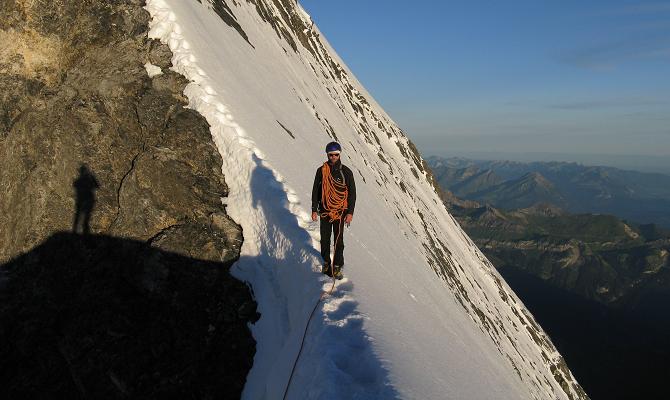 |
 |
| Welcome
to this mountain focus |
 |
 |
 |
 |
 |
We
are in the process of developing these mountain
focus pages for many of the key peaks that we offer
trips too, in order to help people prepare better
for their trips. We are always editing these pages,
so if you have any feedback about information we
should add to the page, please let us know. |
|
 |
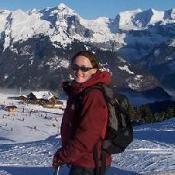 |
 |
This
page has largely been written by Emma
from our Windermere
HQ, and it's here that most people
have their first contact with us, in person or on
the phone. We feel it's important that all our staff
are experts on the mountains we offer trips to,
so we are all involved in developing these focus
pages. |
|
 |
| History
and background |
 |
 |
 |
The
Eiger is one of the most famous and written about peaks
in the world, and due to its famous north face is also
one of the most feared mountains in the world mountains.
It is located in the Bernese Alps, standing at 3,970 metres
(13,020 ft), overlooking Grindelwald and Lauterbrunnen
in the Bernese Oberland. The most notable feature of the
Eiger is its 1,800m (5,900 ft) high north face, named
Eigerwand or Nordwand, which is the biggest north face
in the Alps. The Eiger is within the Swiss Alps Jungfrau-Aletsch
UNESCO World Heritage site, the first UNESCO World Natural
Heritage Site in the Alps, covering an area of 824 square
kilometers, and around 90 percent covered with rocks and
ice.

The first ascent of the Eiger was made by the western
flank on 11 August 1858 by Irishman Charles Barrington,
with Swiss guides Christian Almer and Peter Bohren. They
started at 3:00 a.m. from Wengen. Barrington describes
the route much as it is followed today, staying close
to the edge of the north face much of the way. They reached
the summit at about noon, stayed for some 10 minutes and
descended in about four hours. Barrington describes the
reaching of the top, saying, "the two guides kindly
gave me the place of first man up". Their ascent
was confirmed by observation of a flag left on the summit.
According to Harrer's The White Spider, Barrington was
originally planning to make the first ascent of the Matterhorn,
but his finances did not allow him to travel there as
he was already staying in the Eiger region.

While the summit was reached without much difficulty in
1858 by a complex route on the west flank, the battle
to climb the north face has captivated the interest of
climbers and non-climbers alike. Before it was successfully
climbed, most of the attempts on the face ended tragically
and the Bernese authorities even banned climbing it and
threatened to fine any party that should attempt it again.

The First ascent of the North Face was made in July 1938
by Germans Anderl Heckmair and Ludwig Vörg, and Austrians
Fritz Kasparek and Heinrich Harrer. Heckmair is the lead
climber. This climb is watched intently not only from
the valley below, but also from the air. Bernese photographer
Hans Steiner charters a plane and photographs the four
first ascensionists at the Brittle Ledge and the Brittle
Crack before the weather deteriorates. This image goes
around the world, as does the news of the new mountaineering
milestone. Since 1935, at least sixty-four climbers have
died attempting the north face, earning it the German
nickname Mordwand, literally "murder(ous) wall"
- a pun on its correct title of Nordwand (North Wall). |
 |
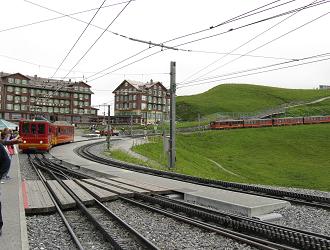  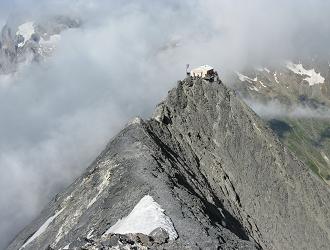 |
 |
| A
word of caution |
 |
 |
 |
Yet
despite the romanticism and the inevitable draw this majestic
peak has there have been many deaths on the mountain and
it is important to realise this is a serious undertaking
and vital that you are competent on steep ground, comfortable
with exposure and are adept with ropework. The
Eiger is not for inexperienced ticklisters, it requires
commitment, and significant rock climbing experience

As we have mentioned before, there are three key points
to remember and to apply on any mountain;

1) The mountain will always be there. Do not push safety
boundaries on ascents as another can be made
2) The key to success is preparation in terms of information,
equipment, training, techniques and planning
3) Never set off considering rescue as an option (unless
there is an accident). Do not play poker with lives. |
 |
| The
key climbing seasons |
 |
 |
 |
Summer
- Our courses for the Ascent of the Eiger only run during
the summer season, and run via the Mittillegi Ridge. Course
dates start from early July to mid-September which is
typically known as the high season in the Alps yet as
with any mountain the weather can be unpredictable, even
more so with recent weather pattern changes.

Winter - For top level Alpinists attempting routes on
the north face, often the spring has become the key time
for them to contemplate the ascents, when the icefields
are in their best condition, and the risks of rock-fall
are at their lowest, as temperatures on the face stay
below zero all through the day. |
 |
  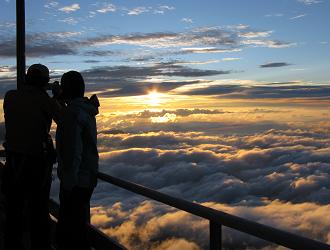 |
 |
| Routes
on the Eiger |
 |
 |
 |
The
Eiger is a striking peak from all sides and a worthy climb
by any of its many routes, none of which are particularly
easy. The most famous route is via the North Face or 'Nordwand'
which is renowned for its difficulty. The easiest way
to the summit is via the West Flank & West Ridge,
which is a very complex route of about the same level
of difficulty as the Hörnli Arête on the Matterhorn
with rock pitches up to III and ice to 40 degrees.

The North Face or 'Nordwand'

The
North Face is world famous not only among climbers, but
also to the general public, mainly due to the number of
deaths on this face. Renowned for bad weather, bad rock,
and bad gear placement options, the face is nicknamed
"Mordwand", a play on the German name of Nordwand
(North Face) that means simply 'death wall'. At least
sixty-four climbers have been killed on the Mordwand since
1935.

The first ascent of the North Face (21/22 to 24 July 1938)
was by Germans Anderl Heckmair (lead climber) and Ludwig
Vörg and Austrians Fritz Kasparek and Heinrich Harrer.
This climb is watched intently not only from the valley
below, but also from the air. Bernese photographer Hans
Steiner charters a plane and photographs the four first
ascensionists at the Brittle Ledge and the Brittle Crack
before the weather deteriorates. The image goes around
the world, as does the news of the new mountaineering
milestone.

Today it is regarded as a formidable challenge more because
of the increased rockfall and diminishing ice-fields than
because of its technical difficulties. Climbers are increasingly
electing to challenge the Eiger in winter, when the crumbling
face is strengthened by ice.

The
West Arete (West Flank & West Ridge)

The
famous first ascent of the Eiger was made by the western
flank (1858), and this route via the west flank and west
ridge is the easiest route to the summit, and the usual
descent route for most parties. Although this is the easiest
route to summit the Eiger, and not that technically difficult,
difficult it is a big high alpine tour that can be especially
serious in poor weather or conditions. Route finding on
the lower part of the flank can be very difficult, especially
in descent if one has not gone up this way initially.

The
Mittillegi Ridge (northeast ridge)

The
first successful summit via the Mittillegi ridge by Englishmen
Francis Chisholm and James Walker Hartley and their two
Grindelwald guides Peter Rubi and Peter Kaufmann in 1874.
The Mittellegi Ridge is a true alpine classic route on
excellent rock and ascends a tremendously exposed ridge
to the summit. The Mittillegi Ridge is The Mittillegi
Ridge is our primary choice for Icicle, as it is objectively
safer and has a longer season in condition.

The
South Ridge

The
first ascent of the south ridge was in 1876 by Briton
George Edward Foster, and the local guides Hans Baumann
and Ulrich Rubi. The South Ridge is the second easiest
on the Eiger.

The
Northeast Face (Lauper Route)

The
Lauper Route takes an elegant line more or less directly
up the Northeast Face. Hans Lauper and Alfred Zücher
with Alexander Graven and Joseph Knubel made the first
ascent of the Northeast Face on 20 August 1932. |
 |
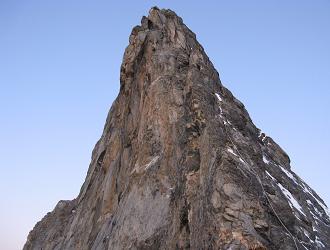   |
 |
| Mittillegi
hut construction |
 |
 |
 |
The
Mittellegi Hut at 3355 m is beautifully situated on the
knife edge sharp Mittellegigrat 615 m under the summit
of the Eiger, the famous Bernese Oberland mountain. The
hut offers two of the most breathtaking views in the Alps,
to the north side green pastoral landscapes with the village
Grindelwald far below, and to the south side massive glaciers
and mountains.

The Mittellegigrat was first ascended 10 September 1921
by the Japanese Yoko Maki together with the three local
guides Fritz Amatter, Samuel Brawand, and Fritz Steuri.
Maki donated a sum of 10.000 Franken for a hut to be built
near the place where they spent the night prior to their
ascent. The hut built in 1924 had room for 16 persons.
A steel pipe bivouac hut was built in 1986 a few meters
from the old hut offering room for further 14 persons. |
 |
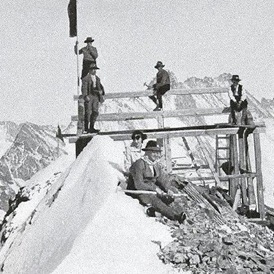 |
 |
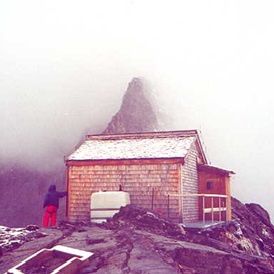 |
 |
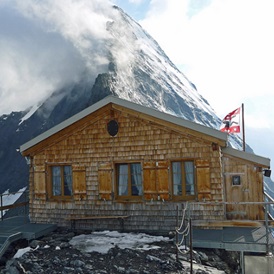 |
 |
 |
 |
| The
original Mittellegi Hut during construction in 1924. |
In
2001, after 77 years, a new larger 40 bed hut was
constructed, and the old was moved to a location
close to the railway station Eigergletscher where
it now serves as a small museum. |
Since
1995 the Mittellegi Hut has a resident guardian
during July and August. Typically (as in the summer
2003) over 700 climbers a year stay here to attempt
the Mittellegigrat the next day. |
|
 |
| Guiding
ratio & grades |
 |
 |
 |
| The
Ascent of the Eiger course run by Icicle is on a 1:2 Guiding
ratio for the first three days, so the Guide can assess
and develop your skills and abilities before attempting
the Eiger (1:1 ratio), to move at your speed. The Eiger
is not for inexperienced ticklisters, it requires commitment,
significant rock climbing experience. The grade alone
does not give a real impression of what the mountain is
really like. It's often described as a hard scramble,
or an easy rock climb, but nothing prepares you for the
amount of loose rock, and it's then that your experience
moving on steep broken mountain ground really kicks in.
The ascent is not too technical, but it often beats people
who are good climbers technically, but who aren't mountaineers.
The top section always requires crampons, so before any
course, you should have sufficient experience on steep
snow / ice too. |
 |
| Preparation
& Acclimatisation |
 |
 |
 |
An
ascent of the Eiger should not be underestimated, and
you should arrive for this course in good physical condition
as the climb will probably be the greatest physical exertion
of your life. Please don't ignore this issue... We highly
recommend that you read our training page (click
here) for details
on how to prepare. If
you are worried about acclimatisation, which is a real
concern for anyone attempting the Eiger, we highly recommend
that you book on an Acclimatisation
Weekend before
your course.

As
mentioned previously we require our clients to have specific
experience, skills and fitness before attempting the Eiger.
While not the most technical course we offer it is important
to be able to move quickly and adeptly up and over rock.
Indoor climbing while great for building up strength and
balance is not a substitute for rock so head to the Lakes
or North Wales: a couple of days getting used to uneven
terrain and gritty rock is a perfect way to improve your
skills never mind escaping those sweaty gyms and having
a douse of fresh air to invigorate your training.

Those
that have not had much experience with crampons could
still attempt the Eiger if they have appropriate rock
climbing experience as it is only the final summit block
that usually demands crampons. We also expect you to have
the required levels of fitness for such a demanding route
not only for bettering your chances of summit success
but also for your own safety and well-being. Please follow
our training plans and, once you think you've reached
the physical peak required train even harder! |
 |
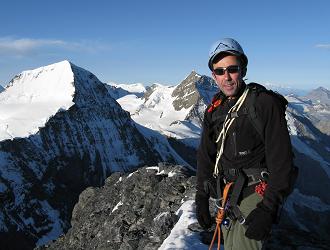  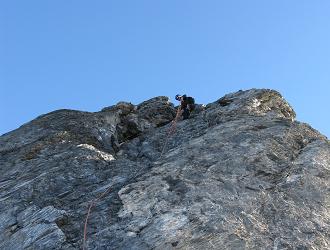 |
 |
| Summary
and postscript to the focus page |
 |
 |
 |
| This
page is constantly updated as a result of changing techniques,
conditions, and latest news. Please don't use this page
alone as the research you undertake for an ascent, and
it does definitely not attempt to offer any of the instruction
of techniques which you will require. Details of many
other sources of information have been provided, which
you should consult before an ascent. Remember that to
climb the Eiger is really a privilege, not a guarantee.
If you found this page of use, and have any other information
that others may find helpful, then please e-mail us. We
will post any useful extra information on the page, and
you will be cited. It is this sharing of knowledge that
makes the climbing community so close, and this extra
knowledge will increase your chances of reaching the summit. |
|
 |
|



